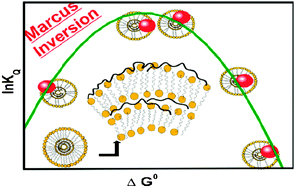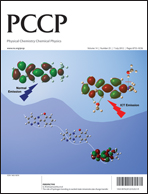Photoinduced electron transfer (ET) reactions between coumarin dyes and N,N-dimethylaniline have been investigated inside niosome, a nonionic innocuous polyethylene glycol (PEG)-based surfactant assembly using steady state and time-resolved fluorescence measurements. The location of coumarin dyes inside the bilayer headgroup region of niosome has been reported and it was verified by determination of the high distribution coefficient of all the dyes inside niosome compared to bulk water. Fluorescence anisotropy parameters of the dyes inside niosome are also in good correlation with the above inference about their location. Bimolecular diffusion guided rates inside niosome were determined by comparing the microviscosities inside niosome and in acetonitrile and butanol solutions and it was found that diffusion of the donor and the acceptor is much slower than the ET rates, implying insignificant role of reactant diffusion in ET reaction inside niosome. We have observed a Marcus inversion region in our restricted media, which shows maxima at lower exergonicity. Such behavior has been demonstrated by the presence of nonequilibrium solvent excited state using two dimensional ET (2DET) theory. Unusually high quenching rates of two coumarins C-152 and C-152A inside niosome were explained by the presence of a stable non-fluorescent twisted intramolecular charge transfer (TICT) state along with an emissive intramolecular charge transfer (ICT) state. Moreover, intermolecular hydrogen bonding between carbonyl oxygens of these two dyes and water in their non-emissive and emissive charge transfer states also plays a key role in their dynamical exchange with each other [G.-J. Zhao and K.-L. Han, Acc. Chem. Res., 2011].

You have access to this article
 Please wait while we load your content...
Something went wrong. Try again?
Please wait while we load your content...
Something went wrong. Try again?


 Please wait while we load your content...
Please wait while we load your content...